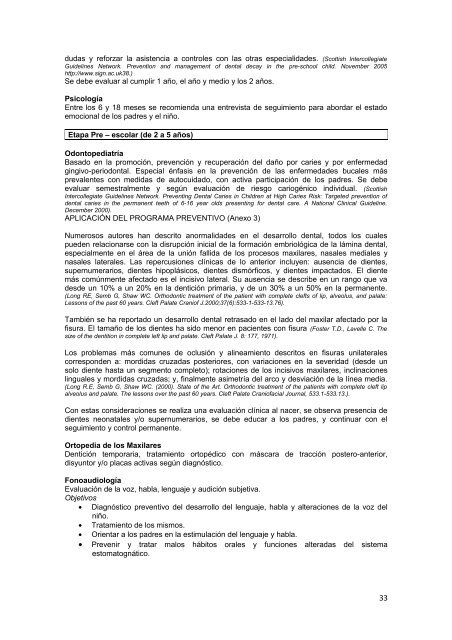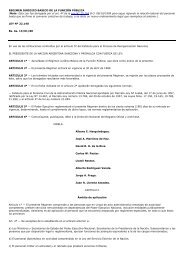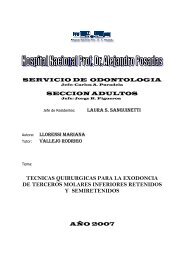Descargar la Guia Clínica para el tratamiento de ... - Hospital Posadas
Descargar la Guia Clínica para el tratamiento de ... - Hospital Posadas
Descargar la Guia Clínica para el tratamiento de ... - Hospital Posadas
Create successful ePaper yourself
Turn your PDF publications into a flip-book with our unique Google optimized e-Paper software.
dudas y reforzar <strong>la</strong> asistencia a controles con <strong>la</strong>s otras especialida<strong>de</strong>s. (Scottish Intercollegiate<br />
Guid<strong>el</strong>ines Network. Prevention and management of <strong>de</strong>ntal <strong>de</strong>cay in the pre-school child. November 2005<br />
http://www.sign.ac.uk38.)<br />
Se <strong>de</strong>be evaluar al cumplir 1 año, <strong>el</strong> año y medio y los 2 años.<br />
Psicología<br />
Entre los 6 y 18 meses se recomienda una entrevista <strong>de</strong> seguimiento <strong>para</strong> abordar <strong>el</strong> estado<br />
emocional <strong>de</strong> los padres y <strong>el</strong> niño.<br />
Etapa Pre – esco<strong>la</strong>r (<strong>de</strong> 2 a 5 años)<br />
Odontopediatría<br />
Basado en <strong>la</strong> promoción, prevención y recuperación d<strong>el</strong> daño por caries y por enfermedad<br />
gingivo-periodontal. Especial énfasis en <strong>la</strong> prevención <strong>de</strong> <strong>la</strong>s enfermeda<strong>de</strong>s bucales más<br />
prevalentes con medidas <strong>de</strong> autocuidado, con activa participación <strong>de</strong> los padres. Se <strong>de</strong>be<br />
evaluar semestralmente y según evaluación <strong>de</strong> riesgo cariogénico individual. (Scottish<br />
Intercollegiate Guid<strong>el</strong>ines Network. Preventing Dental Caries in Children at High Caries Risk: Targeted prevention of<br />
<strong>de</strong>ntal caries in the permanent teeth of 6-16 year olds presenting for <strong>de</strong>ntal care. A National Clinical Guid<strong>el</strong>ine.<br />
December 2000).<br />
APLICACIÓN DEL PROGRAMA PREVENTIVO (Anexo 3)<br />
Numerosos autores han <strong>de</strong>scrito anormalida<strong>de</strong>s en <strong>el</strong> <strong>de</strong>sarrollo <strong>de</strong>ntal, todos los cuales<br />
pue<strong>de</strong>n re<strong>la</strong>cionarse con <strong>la</strong> disrupción inicial <strong>de</strong> <strong>la</strong> formación embriológica <strong>de</strong> <strong>la</strong> lámina <strong>de</strong>ntal,<br />
especialmente en <strong>el</strong> área <strong>de</strong> <strong>la</strong> unión fallida <strong>de</strong> los procesos maxi<strong>la</strong>res, nasales mediales y<br />
nasales <strong>la</strong>terales. Las repercusiones clínicas <strong>de</strong> lo anterior incluyen: ausencia <strong>de</strong> dientes,<br />
supernumerarios, dientes hipoplásicos, dientes dismórficos, y dientes impactados. El diente<br />
más comúnmente afectado es <strong>el</strong> incisivo <strong>la</strong>teral. Su ausencia se <strong>de</strong>scribe en un rango que va<br />
<strong>de</strong>s<strong>de</strong> un 10% a un 20% en <strong>la</strong> <strong>de</strong>ntición primaria, y <strong>de</strong> un 30% a un 50% en <strong>la</strong> permanente.<br />
(Long RE, Semb G, Shaw WC. Orthodontic treatment of the patient with complete clefts of lip, alveolus, and pa<strong>la</strong>te:<br />
Lessons of the past 60 years. Cleft Pa<strong>la</strong>te Craniof J.2000;37(6):533-1-533-13.76).<br />
También se ha reportado un <strong>de</strong>sarrollo <strong>de</strong>ntal retrasado en <strong>el</strong> <strong>la</strong>do d<strong>el</strong> maxi<strong>la</strong>r afectado por <strong>la</strong><br />
fisura. El tamaño <strong>de</strong> los dientes ha sido menor en pacientes con fisura (Foster T.D., Lav<strong>el</strong>le C. The<br />
size of the <strong>de</strong>ntition in complete left lip and pa<strong>la</strong>te. Cleft Pa<strong>la</strong>te J. 8: 177, 1971).<br />
Los problemas más comunes <strong>de</strong> oclusión y alineamiento <strong>de</strong>scritos en fisuras uni<strong>la</strong>terales<br />
correspon<strong>de</strong>n a: mordidas cruzadas posteriores, con variaciones en <strong>la</strong> severidad (<strong>de</strong>s<strong>de</strong> un<br />
solo diente hasta un segmento completo); rotaciones <strong>de</strong> los incisivos maxi<strong>la</strong>res, inclinaciones<br />
linguales y mordidas cruzadas; y, finalmente asimetría d<strong>el</strong> arco y <strong>de</strong>sviación <strong>de</strong> <strong>la</strong> línea media.<br />
(Long R.E, Semb G, Shaw WC. (2000). State of the Art. Orthodontic treatment of the patients with complete cleft lip<br />
alveolus and pa<strong>la</strong>te. The lessons over the past 60 years. Cleft Pa<strong>la</strong>te Craniofacial Journal, 533.1-533.13.).<br />
Con estas consi<strong>de</strong>raciones se realiza una evaluación clínica al nacer, se observa presencia <strong>de</strong><br />
dientes neonatales y/o supernumerarios, se <strong>de</strong>be educar a los padres, y continuar con <strong>el</strong><br />
seguimiento y control permanente.<br />
Ortopedia <strong>de</strong> los Maxi<strong>la</strong>res<br />
Dentición temporaria, <strong>tratamiento</strong> ortopédico con máscara <strong>de</strong> tracción postero-anterior,<br />
disyuntor y/o p<strong>la</strong>cas activas según diagnóstico.<br />
Fonoaudiología<br />
Evaluación <strong>de</strong> <strong>la</strong> voz, hab<strong>la</strong>, lenguaje y audición subjetiva.<br />
Objetivos<br />
• Diagnóstico preventivo d<strong>el</strong> <strong>de</strong>sarrollo d<strong>el</strong> lenguaje, hab<strong>la</strong> y alteraciones <strong>de</strong> <strong>la</strong> voz d<strong>el</strong><br />
niño.<br />
• Tratamiento <strong>de</strong> los mismos.<br />
• Orientar a los padres en <strong>la</strong> estimu<strong>la</strong>ción d<strong>el</strong> lenguaje y hab<strong>la</strong>.<br />
• Prevenir y tratar malos hábitos orales y funciones alteradas d<strong>el</strong> sistema<br />
estomatognático.<br />
33





